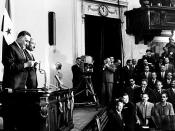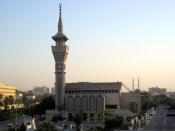Egyptian Allegiance Under Nasser
During Gamal Abdel Nasser's presidency in Egypt, which ran through the early 50's to the late 60's, the Cold War had both the Soviet Union and the United States gathering countries to form blocs with which they attempted to outdo each other's world influence. Egypt experienced Western rule as a British protectorate, and in 1919, a rebellion against the British was the first sign of Egyptian unrest with the European domination (Milner). Nasser found the Soviet Union and its policies to be attractive due the "presence of a common enemy and its influence"(Aburish, 275). The financing for the Aswan high dam, the nationalization of the Suez Canal, and the Six-Day War of 1967 pushed Nasser away from Western unity and into the influence of the Soviet Union.
Nasser had become an Egyptian nationalist as a young boy (St. John, 1). After attending the Military Academy he led the Free Officers coup of July 23, 1952 that removed a corrupt monarchy, declared independence from Britain, and established social reforms to give an identity to the Egyptians.
Nasser continuously gained political domination and was elected President in 1956. His presidency defined sociopolitical elements and an authoritarian single-party rule. Nasser established land and health reform; public education; nationalization of heavy industry, and pan-Arabism. Egyptians remember him as a hero, and his era as one of "pride and unity" (Goldstone, 363).
Throughout history and well into today, the Nile River serves as the lifeblood in Egypt. Due to Egypt's mostly desert terrain, the Egyptian population is concentrated around the banks of the Nile (Cutter, 225). During his presidency, Nasser had begun to consider rebuilding the Aswan Dam to increase production in Egyptian irrigation and provide power for other industries (Nutting, 112). The construction of the dam was to cost...


